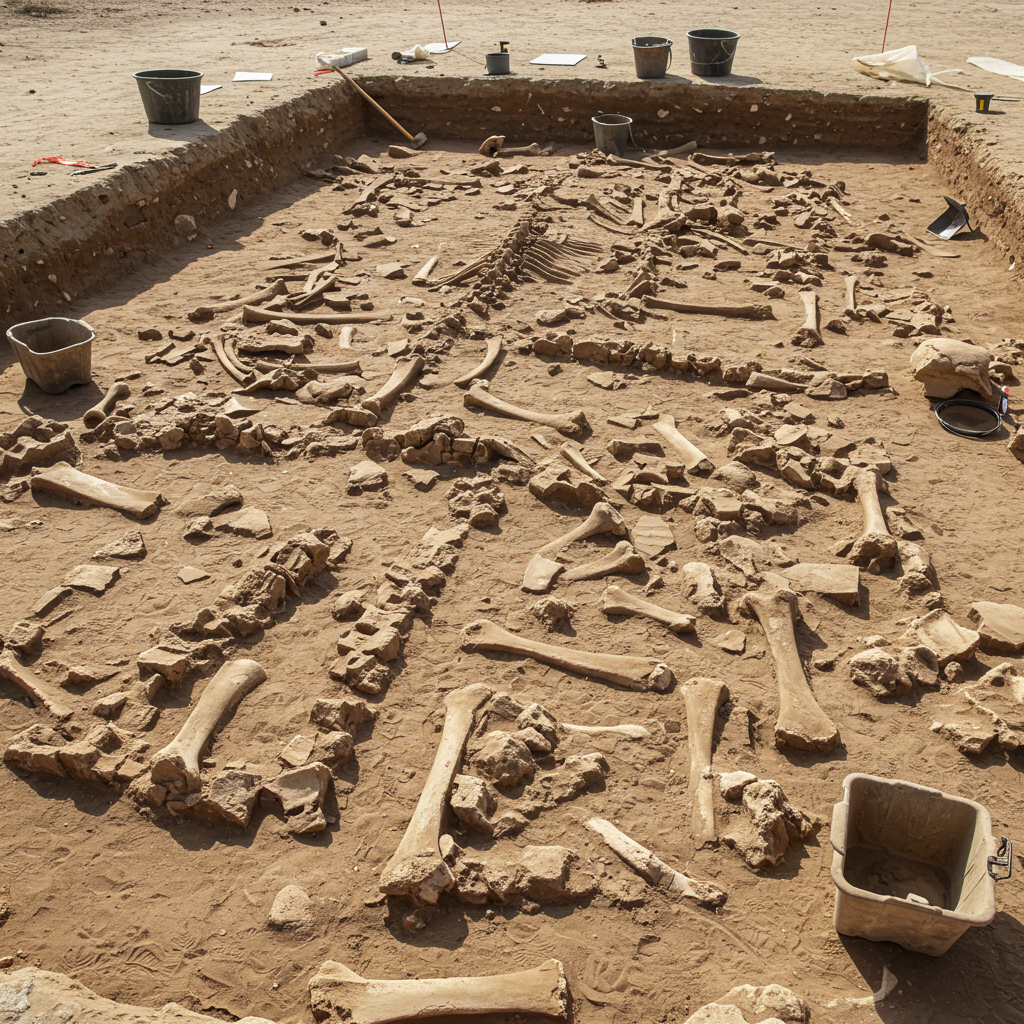A groundbreaking archaeological discovery in Germany reveals that neanderthals possessed surprisingly sophisticated culinary and resource management skills much earlier than previously thought. Evidence from a 125,000-year-old site indicates they were systematically processing animal bones on a massive scale to extract nutrient-rich fat or grease. This practice, previously associated primarily with later modern humans, highlights the complex adaptive strategies of our ancient cousins.
Unearthing an Ancient “Fat Factory”
The extraordinary findings come from the Neumark-Nord site in eastern Germany. This ancient lakeside location has yielded a remarkable collection of over 100,000 bone fragments. These fragments belong to at least 172 individual large mammals. The diverse animal remains include horses, bovids, deer, foxes, big cats, and even an extinct two-horned rhinoceros. Researchers describe the site as a dedicated “fat factory.” It suggests an intensive, organized activity focused on extracting valuable nutrients.
Archaeologists found these bone fragments mixed with flint artifacts and hammer stones. This association indicates that processing activities took place right there. The sheer quantity of bone material gathered at this spot points to strategic planning. Neanderthals transported these carcasses to this specific location. This wasn’t just opportunistic scavenging. It was a deliberate, large-scale operation.
The Complex Process of Bone Grease Rendering
Analyzing the bone fragments provided key clues about how Neanderthals worked. The bones showed clear signs of being intentionally smashed into small pieces. Researchers noted this fragmentation is “clearly anthropogenic,” meaning it was caused by humans. This level of processing required significant effort. It wasn’t merely breaking bones for marrow. It was a systematic reduction of bone material.
Following fragmentation, the bones were heated. Evidence of this heating includes visibly burnt bone fragments, heated flint artifacts, and stones found at the site. While direct evidence of boiling vessels is absent (pottery came much later), scientists suggest Neanderthals likely used containers made from perishable materials. These might have included deer skin or birch bark placed directly on fires. Modern experiments show such vessels could reach temperatures suitable for extracting fat. This process would liberate grease from the spongy tissue inside the bones. It was a labor-intensive but effective method.
Why Bone Fat Was a Dietary Game Changer
For ancient hunter-gatherer groups like Neanderthals, fat was a highly prized resource. It provides more than double the calories per gram compared to protein or carbohydrates. Fat also offers essential fatty acids. It would have been a less-perishable food source than muscle meat. It was also easily transportable once rendered.
A diet heavily reliant on lean meat can lead to “protein poisoning,” also known as rabbit starvation. This potentially lethal condition results from consuming excessive protein without enough fat or carbs. Given their meat-focused diet, Neanderthals likely faced this risk. Extracting bone fat would have provided a vital energy buffer. It protected them against nutritional imbalances. This sophisticated nutritional strategy was crucial for survival, especially in challenging environments.
Challenging Old Perceptions of Neanderthals
This discovery significantly updates our understanding of Neanderthal capabilities. It shows they were not just simple cave dwellers. They engaged in complex planning and resource management. The scale of bone processing at Neumark-Nord suggests forethought. It points to a potential for food storage. This behavior makes Neanderthals seem much more similar to historically documented foraging societies than previously thought.
This finding joins other evidence of Neanderthal complexity. They were skilled toolmakers. They produced sophisticated materials like birch bark pitch, which required precise temperature control. The “fat factory” adds another layer to this picture. It demonstrates their adaptive intelligence. They were clearly managing resources strategically. They understood both the nutritional value of fat and the technical process to extract it efficiently.
Broader Implications for Human Evolution
The intensive production of bone grease was previously thought to be unique to Upper Paleolithic Homo sapiens. The Neumark-Nord discovery pushes back the timeline for this complex nutritional strategy by tens of thousands of years. The earliest previously confirmed evidence for intensive grease rendering by Neanderthals was from a much later site in Portugal. This German site is nearly 100,000 years older than similar known activities by modern humans.
Understanding Neanderthal dietary practices is vital for studying human adaptation and evolution. The caloric benefits of fat extraction improved their diet. This could have supported larger populations. It might have influenced lifespans and reproductive success. Furthermore, the sheer volume of animals processed suggests a significant impact on the local environment. Mass hunting of large, slow-reproducing species likely altered the regional fauna during the Last Interglacial period.
Frequently Asked Questions
How did ancient Neanderthals extract fat from animal bones?
Neanderthals at the Neumark-Nord site 125,000 years ago used a complex process. They first smashed large animal bones into small fragments. Then, they likely heated or boiled these fragments, possibly in perishable containers like skin bags. This heating process released grease from the spongy bone tissue. This high-calorie fat could then be collected and consumed.
Where was the Neanderthal “fat factory” site discovered?
The archaeological site identified as a Neanderthal “fat factory” is located at Neumark-Nord in eastern Germany. This ancient lakeside location yielded over 100,000 bone fragments from numerous large animals. The concentration of processed bones and tools there indicates it was a specific area dedicated to intensive bone grease extraction.
Why was bone fat extraction important for the Neanderthal diet?
Extracting bone fat provided a vital, energy-rich food source for Neanderthals. Fat contains significantly more calories than protein or carbohydrates. For a meat-heavy diet, sufficient fat was crucial to avoid “protein poisoning.” This practice maximized nutritional yield from animal carcasses, improving their chances of survival and supporting their active hunter-gatherer lifestyle.
A Legacy of Ingenuity
The discovery of the Neumark-Nord “fat factory” fundamentally changes our view of Neanderthals. It paints a picture of a sophisticated species capable of complex planning, resource intensification, and technical innovation. Their ability to extract valuable fat from bones on a large scale demonstrates a deep understanding of nutrition and environment. This finding reminds us that our ancient human relatives were far more capable and adaptable than often portrayed, leaving a legacy of ingenuity in the Paleolithic world.
Word Count Check: 815




